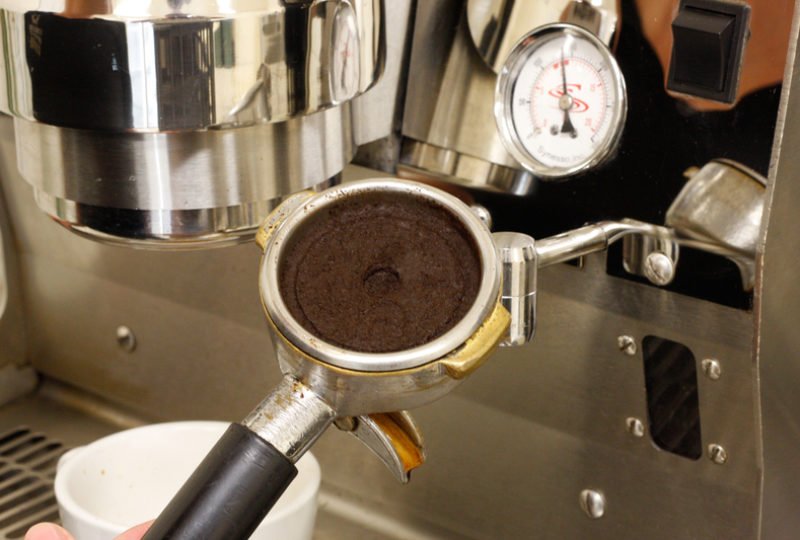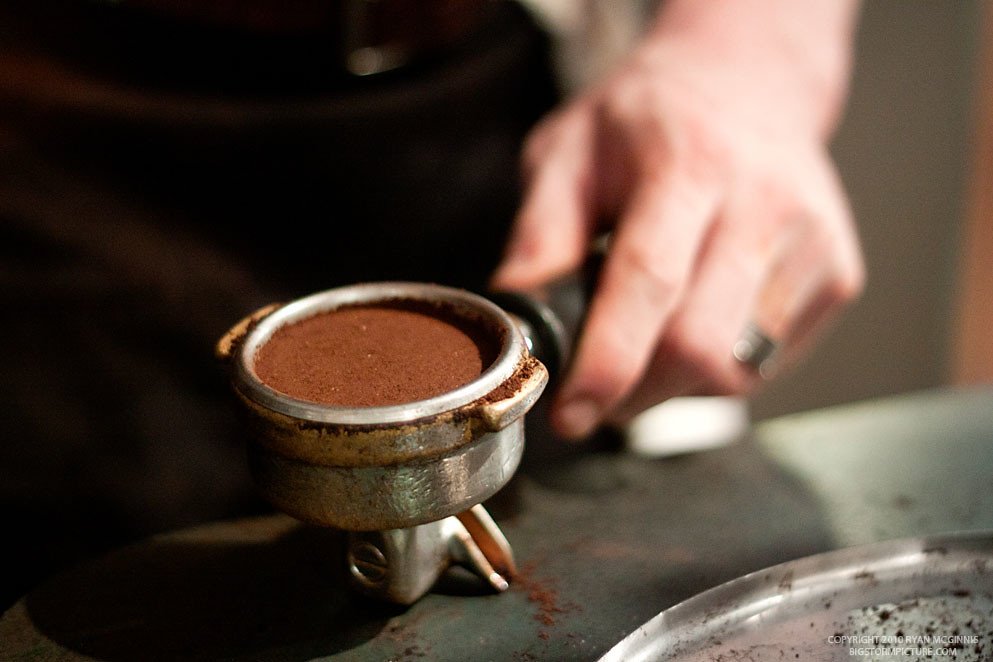In the art of brewing espresso, the crucial extraction process involves water passing through a densely compacted bed of coffee grounds known as the espresso puck. However, it’s not uncommon for this puck to stubbornly adhere to the grouphead of the espresso machine, causing frustration and disruptions in the coffee-making routine. This article explores the reasons behind this issue and offers practical solutions to ensure a seamless and enjoyable espresso brewing experience.
Espresso preparation is an art that demands precision and meticulous attention to detail. The quest for the perfect shot of espresso hinges on a delicate equilibrium of factors, including grind size, tamping pressure, coffee distribution, and equipment maintenance. Among these variables, the phenomenon of an espresso puck adhering to the grouphead can pose a perplexing challenge. It’s a situation that can catch even the most experienced baristas off guard, potentially resulting in wasted coffee, extended preparation times, and the risk of espresso machine damage if not handled correctly. To surmount this hurdle and uphold the quality of your espresso, it’s imperative to comprehend the underlying causes and implement effective remedies. Let’s delve into the intricacies of the “Espresso Puck Stuck To Grouphead” issue and discover how to confidently overcome it.
Bid farewell to those sticky predicaments and welcome back the joy of your daily espresso ritual.
Coffee Grind Size Mismatch
When it comes to preventing the dreaded issue of an Espresso Puck Stuck To Grouphead, one of the crucial factors to consider is the coffee grind size. The grind size plays a pivotal role in the brewing process, as it determines how fast or slow water flows through the coffee grounds. A common reason for a stuck puck is a Coffee Grind Size Mismatch. If your coffee grounds are too fine for your espresso machine, they can compact tightly and cause the puck to adhere stubbornly to the grouphead.
To address this problem effectively, it’s essential to ensure that your coffee grind size is compatible with your espresso machine. Experiment with different grind settings until you find the right one that allows for a smooth and consistent extraction. A finer grind size generally slows down the flow of water, while a coarser grind size allows water to pass through more quickly. Finding the perfect balance can significantly reduce the chances of encountering an Espresso Puck Stuck To Grouphead, ensuring a smoother and more enjoyable espresso-making experience.
Tamping Pressure

Tamping pressure plays a crucial role in the world of espresso-making, and it directly relates to the issue of an espresso puck getting stuck to the grouphead. The puck, which consists of tightly compacted coffee grounds in the portafilter, needs to be tamped with consistent and even pressure to ensure that it forms a uniform bed for the water to pass through during the brewing process.
When tamping pressure is inconsistent or uneven, it can result in an uneven espresso puck. This unevenness can lead to channels forming within the puck, allowing water to flow through the path of least resistance, rather than evenly saturating the coffee grounds. As a consequence, part of the puck may become stuck to the grouphead, obstructing the flow of espresso and causing brewing problems.
To address this issue, it’s essential to pay close attention to your tamping technique. Ensure that you apply the same amount of pressure evenly across the entire surface of the coffee grounds in the portafilter. Using a calibrated tamper can help you maintain a consistent pressure, preventing the formation of gaps or inconsistencies within the puck. By mastering your tamping technique, you can significantly reduce the likelihood of an espresso puck getting stuck to the grouphead and enjoy a more consistent and flavorful espresso extraction.
Coffee Distribution
Coffee Distribution plays a pivotal role in preventing the dreaded issue of an Espresso Puck Stuck To Grouphead. When coffee grounds are not evenly distributed within the portafilter, it can result in an uneven puck formation, causing water to flow unevenly through the coffee bed during extraction. This uneven flow can lead to channeling and, eventually, a stuck puck.
To address this problem effectively, the key solution is to use a distribution tool or employ the Weiss Distribution Technique (WDT). These methods are designed to ensure the coffee grounds are evenly distributed in the portafilter basket. A distribution tool, often known as a leveling or distribution tool, allows you to evenly distribute the grounds by simply sweeping it across the coffee bed. This levels the grounds and promotes uniform extraction, reducing the likelihood of a stuck puck.
The Weiss Distribution Technique, on the other hand, involves using a fine, thin needle or toothpick to gently stir the coffee grounds in the portafilter. This method breaks up clumps and ensures an even distribution of coffee throughout the basket. By adopting either of these techniques, you can significantly improve the consistency of your espresso extractions and minimize the chances of encountering an Espresso Puck Stuck To Grouphead issue.
Coffee Freshness

When it comes to the frustrating issue of an espresso puck stuck to the grouphead, one crucial factor often gets overlooked – the freshness of your coffee grounds. The reason behind a stubborn puck can frequently be traced back to the quality of your coffee beans. Stale coffee grounds tend to clump together, making it difficult for water to flow through them evenly during the brewing process.
The solution to this problem is straightforward: prioritize using freshly roasted and properly stored coffee beans. Coffee beans are at their peak flavor and aroma within a certain timeframe after roasting. Over time, they lose these qualities and become stale. By choosing beans that are within this optimal freshness window, you can ensure that your coffee grounds are more likely to produce a consistent and manageable puck.
To maintain the freshness of your coffee beans, store them in an airtight container in a cool, dark place. Avoid exposing them to air, moisture, or direct sunlight, as these elements can accelerate the deterioration of your coffee’s flavor. By taking these steps, you’ll not only improve your espresso puck consistency but also enhance the overall quality of your coffee.
Cleaning and Maintenance
Neglecting the cleanliness of your grouphead can be a significant factor when dealing with the issue of an espresso puck stuck to the grouphead. The grouphead is a critical component of your espresso machine, and any accumulation of coffee residue or oils in this area can lead to complications during the brewing process. Over time, these residues can harden, making it more challenging to remove the puck and affecting the overall performance of your machine.
To address this concern, it’s essential to make regular cleaning and maintenance of your espresso machine, particularly the grouphead area, a priority. Cleaning the grouphead involves removing the portafilter and thoroughly wiping down the grouphead screen, gasket, and surrounding surfaces. Use a soft cloth or a specialized brush to ensure that no coffee residues are left behind. Additionally, it’s advisable to perform backflushing, a more thorough cleaning process, at regular intervals to prevent any buildup of oils and debris inside the grouphead.
By incorporating a diligent cleaning and maintenance routine into your espresso machine care, you can significantly reduce the chances of encountering the frustrating problem of an espresso puck stuck to the grouphead. This proactive approach not only ensures the consistent quality of your espresso but also extends the lifespan of your machine, ultimately enhancing your overall coffee brewing experience.
In conclusion, dealing with an espresso puck stuck to the grouphead of your espresso machine can be a frustrating experience for any coffee enthusiast or barista. However, armed with the knowledge of the five common reasons and easy solutions we’ve discussed, you can overcome this issue and continue to enjoy the delightful world of espresso without interruptions.
By paying attention to crucial factors such as coffee grind size, tamping pressure, coffee distribution, coffee freshness, and regular machine maintenance, you can ensure that your espresso pucks slide out smoothly, resulting in consistently excellent coffee shots. Remember that a well-maintained and properly used espresso machine is the key to a consistently satisfying coffee experience.
Don’t let a stuck espresso puck deter you from perfecting your barista skills or enjoying your daily caffeine fix. Instead, use these insights to troubleshoot and resolve the issue promptly. With practice and attention to detail, you’ll become adept at creating delicious, puck-free espresso shots that will impress even the most discerning coffee connoisseurs.

![Why Is Espresso Too Acidic [5 Reasons To Solve!] Why Is Espresso Too Acidic [5 Reasons To Solve!]](https://reviewnery.com/wp-content/uploads/2023/03/espresso-too-acidic-211x150.webp)




